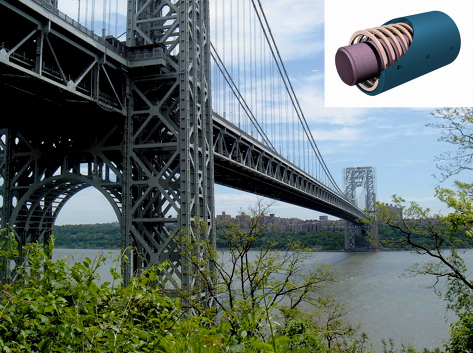- Home
- Users & Science
- Scientific Documentation
- ESRF Highlights
- ESRF Highlights 2008
- X-ray absorption and magnetic scattering
- Atomic-scale magnetostriction
Atomic-scale magnetostriction
Magnetostriction refers to the change in physical dimensions of a magnetic material, observed when there is a change in its magnetisation. It was first described by James Joule in 1842 and originates from spin-orbit coupling, where magnetic energy is converted to mechanical energy and vice versa. However, despite the obvious applications of such an effect in transducer devices, the strain produced in common magnetic materials is only a few tens of parts-per-million (ppm) at most. It was, therefore, not until the discovery of room-temperature ‘giant’ magnetostriction in rare-earth transition metal alloys in the 1970s that interest developed in magnetostrictive transducer technologies (Figure 112).
 |
|
Fig. 112: In a typical magnetostrictive actuator, a magnetostrictive material (central rod) is wrapped in a metal coil, which is in turn housed in an outer casing. By passing a current through the coil, a magnetic field is formed within in, causing the rod to extend. Alternatively, the device may operate in reverse as a sensor, where external pressures change the length of the rod, which in turn generates a magnetic field that induces a measurable current in the coil. Such sensors are frequently employed for non-destructive testing applications, such as examination of suspender cables on bridges. |
More recently, a different class of material based on binary metal alloys such as Fe-Al or Fe-Ga, have attracted considerable interest. It is well known that pure Fe exhibits only an extremely small magnetostriction (just 20 ppm), but experiments have revealed that when it is alloyed with certain nonmagnetic metallic elements, the magnetostriction can be enhanced by over an order of magnitude. Compositions of Fe-Ga with around 19at% Ga have reported strains of up to 400 ppm. Although this doesn’t constitute a truly ‘giant’ magnetostriction, it is of interest for device applications since Fe-Ga is devoid of expensive rare-earth components, and possesses more desirable mechanical properties than, say, the much studied Terfenol-D alloy.
From a theoretical perspective, initial proposals for the source of this enhancement suggested it arose from clustering of the Ga atoms within a disordered Fe lattice, to provide both elastic and magnetoelastic defects. More recently, magnetostriction coefficients have been derived from first-principles calculations, and the magnetocrystalline anisotropy modelled, which together, suggested that such defects could be better formed by pairs of Ga atoms, arranged randomly throughout the material. To verify these proposals, it is clear that atomic-scale structure and strain measurements are needed. Yet this is where problems arise.
Experimentally, magnetostrictive strain is elusive at the atomic scale. Strains of the order of tens of ppm only generate displacements between atoms of the order of femtometres, which are extremely difficult to detect. Even commonly employed atomic probes, such as X-ray Absorption Spectroscopy (XAS), lack the sensitivity to observe such motion by up to two orders of magnitude. As a result, experiments largely deal with magnetostriction in a scaled-up form. Typical measurements employ strain gauges on large, macroscopic samples, where the strain is easier to detect, but where atomic information is lost.
However, with the recent development of differential XAS (DiffXAS) on beamline ID24 – a new technique designed specifically for the measurement of strains down to the scale of femtometres – such direct, atomic-scale measurements have become possible. When these are coupled to conventional XAS data (from beamline BM29), the static structure may also be obtained in the absence of an applied magnetic field, providing a complete picture of the sample behaviour.
Recently, we have carried out DiffXAS and XAS experiments on samples of Fe81Ga19, where the magnetostriction enhancement with respect to pure Fe is maximised. From the conventional XAS measurements, we were able to examine the static atomic structure immediately surrounding the Ga atoms, and found that there were no Ga clusters – in the first atomic coordination shell around Ga, there were no Ga-Ga bonds. Furthermore, in the second coordination shell, we found, on average, exactly one Ga-Ga bond – testifying to the presence of the Ga-Ga pair defects predicted by theory.
With an applied magnetic field, the DiffXAS measurements showed the way this structure deformed. By examining the surroundings of the Fe and Ga atoms individually, we established that the strain emanated from the environment around the Ga atoms. Here, the magnitude of the strain was about 400 ppm, compared to only 40 ppm around Fe. More importantly, negligible strain was found in the Ga-Ga pair defect itself. We could therefore conclude that the pair defect simply mediates the magnetostriction in the material rather than providing it directly. Instead, and in agreement with theory, the enhanced magnetostrictive strain in Fe81Ga19 arises from the Ga-Fe bonds in the immediate vicinity of the Ga-Ga pair defects.
Principal publications and authors
M.P. Ruffoni (a), S. Pascarelli (a), R. Grössinger (b), R. Sato-Turtelli (b), C. Bormio-Nunes (c), R.F. Pettifer (d), Phys. Rev. Lett. 101, 147202 (2008); S. Pascarelli (a), M.P. Ruffoni (a), R. Sato-Turtelli (b), F. Kubel (b), R. Grössinger (b), Phys. Rev. B 77, 184406 (2008).
(a) ESRF
(b) Vienna University of Technology (Austria)
(c) Universidade de Sao Paulo, Lorena-SP (Brasil)
(d) University of Warwick, Coventry (UK)



